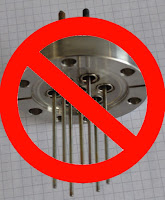 |
| Glass-to-metal feedthrough |
Glass-to-metal and ceramic-to-metal seals, traditionally the preferred technology, are increasingly problematic - not because of their performance, but because they are constrained by size, geometry, flexibility, and electro-magnetic shielding options. Engineers worked within this reality simply because there were no viable alternatives. Fortunately though, new, advanced sealing epoxy compounds were developed that provided exciting opportunities for vacuum feedthrough manufacturers.
Faster, Less Expensive, More Customizable Feedthroughs
 |
| Epoxy vacuum feedthrough. |
Today's epoxy vacuum feedthroughs provide the virtually the same performance as their glass and ceramic cousins in low to medium temperatures. Epoxy vacuum feedthroughs offer designers and engineers an excellent alternative in terms of customization and specialization. Shapes, angles and curves are not a problem. Virtually any kind of shielded wire or cable can be used. Custom epoxy vacuum feedthroughs can be quickly provided in very small quantities for prototyping and R&D. Modern epoxy feedthroughs maintain a vacuum up to 10-8 Torr, with temperatures up to 200°C continuous (300°C intermittent), and also meet NASA's outgassing requirement of <1.0% Total Mass Loss (TML). Liquid epoxy's ability to flow and fill spaces thoroughly provides it's advantage, and in most applications, an epoxy feedthrough can be used where a glass-to-metal or ceramic feedthrough is used - the only notable exceptions are in very high temperature applications or where organic compounds are not allowed.
Designers and engineers no longer have to think within the constrained world of glass-to-metal and ceramic-to-metal feedthroughs. Epoxy feedthroughs are a new, exciting player in town, and their lower cost, easy prototyping and more flexible design capability make them a very attractive alternative.
For more information, visit https://BCEmfg.com or call BCE at (510) 274-1990